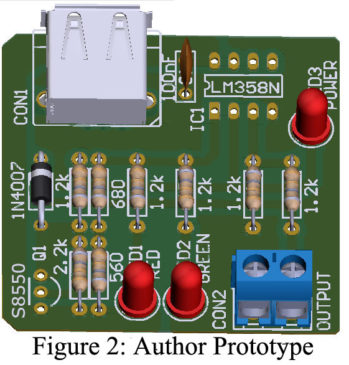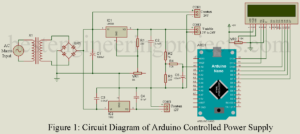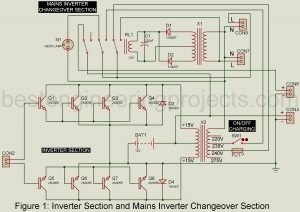Most of us hear about the variable power supply, it is a power supply unit that provides almost all standard power supplies. How’s that if we combine a variable power supply and a digital control technology. Here, we have designed and verified a DC power supply circuit with the facility of digital control. The unit digital power supply circuit provides a variable, fluctuation-free and regulated ten different DC power supplies. These are 1.5V, 3V, 4.5V, 5V, 6V, 7.5V, 9V, 10.5V, 12V positive power supply, and 12V negative power supply. One…
Read MoreCategory: power supply
Automatic Lead Acid Battery Charger Circuit
An automatic lead acid battery charger circuit is designed to charge 12V, and 40Ah in different charging modes i.e. boost mode and float mode. This circuit can be used to charge large-capacity inverter batteries by replacing transformers and power transistors with higher ratings. To know the condition of the battery and charger unit, this circuit was incorporated with an audiovisual indication unit. Before going to the circuit description and working let’s see its salient features: Features of Automatic Lead Acid Battery Charger Circuit Automatic charger the battery and maintain the…
Read MoreLiFePO4 Battery Charger Circuit
Lithium Iron Phosphate LiFePO4 or Li-Fe battery is the latest generation of Li-ion battery and is popular among electronics hobbyists because of its features like high discharge current rate, safety and it is the least toxic of all battery types. Also, these batteries are safer because of the chemistry involved to make them. It contains a very stable composition of phosphate as a result longer life span of the battery can be achieved. However, the latest generation Li batteries are non-inflammable and are capable of bearing extreme conditions. In this…
Read MoreNoise Free Dual Polarity 12V Power Supply Circuit
Power supply has been considered a role in an electronic circuit. Power supply furnishes the voltage and current requirements for electronics circuit operation but the problem is most of the electric power is generated as AC power. But for the operation of most of the electronics circuits, we need a DC power supply. Sometimes the output of the power supply consisting unwanted ripple components i.e. component of supply frequency and its harmonics. We should take care of this unwanted noise or harmonic components because this might cause problems (especially in…
Read More12V Lead Acid Battery Charger Circuit
There are lots of 12V Lead Acid Battery Charger Circuit available over the internet but does not include a battery status indicator. If you wish to know the status of the battery like dead, charged, or charging you need an extra circuit. In order to solve these problems, we combined three different circuits and hence do three different dedicated jobs like charging the battery, indicating the status of the battery, and also have a dedicated port for variable power supply connector of bench power supply in case you need. This…
Read MoreArduino Controlled Variable Power Supply
We all know that the power supply is the most basic unit of any electric/electronics circuit. The mostly electronic project, we have seen SLA batteries are often used, but they drain and we cannot get all-day performance. It is better to use the battery for backup rather than the main power supply. Another problem with using the battery is, when we draw high current constantly it becomes hot, it might create some serious issue, don’t think about this care? Don’t worry, the circuit Arduino Controlled Variable Power Supply is designed…
Read MoreHigh Low Voltage Cutout Circuit
The protection of electrical and electronic appliances is the main concern these days. Some electronics appliance is very sensitive to voltage i.e. it only functions when adequate voltage is provided. Some appliances were even destroyed due to high and low voltage supply. To solve this type of issue we are posting a very simpler and more useful project called “High Low Voltage Cutout Circuit”. Previously we had already posted various types of appliance protecting circuits on bestengineeringprojects.com like: Auto Cut Circuit for Over and Under Voltage High Current Regulator Circuit…
Read MoreAutomatic battery float charger circuit
Automatic battery float charger circuit: This article aims to develop a battery charger circuit using the principle float charging technique. Afloat charger is also referred to as a smart charger, maintenance charger, or storage charger because it charges the battery at the same rate at which it self-discharges. The main reason for using a float charger is, that it protects the battery from overcharging and deep discharging. Thus, you can connect the float charger circuit to a battery for indefinite intervals of time i.e. there is no need to disconnect…
Read MoreOffline UPS Circuit
Introduction to Offline UPS Circuit We all know that most electrical and electronic appliances are solely powered by the AC supply and the problem arises when the power is cut off in the middle or there is no power at all. In such cases, uninterrupted supplies are what we look out for. This is one of those uninterrupted power supply circuits. The fact that it provides an instant power supply from the batteries than standby generators that take long to operate, makes it more practical. To make the use of…
Read More3.7V to 5V, 5.3V and 6V Converter Circuit
3.7V to 5V, 5.3V, and 6V Converter Circuit: The preferred voltage levels while working in most electronics projects lie between the value 5V to 6V. However, 3.6V-3.7V batteries are found abundantly in the market with a cheap price tag. So, we presented an economic solution to generate commonly used operating voltages i.e. 5V, 5.3V, and 6V using these cheap and easily available 3.6V and 3.7V batteries. Using two-three batteries of 3.6V (3.6*2=7.2V) and 3.7V (3.7*2=7.4V) doesn’t provide the desired voltage level and thus this project was essential. This DC-to-DC converter…
Read More








